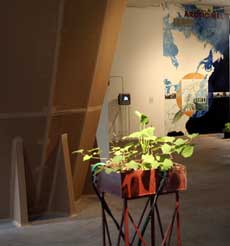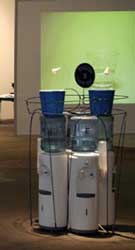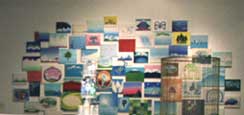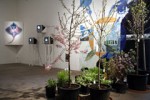Post by Amy Lipton
[Ed. note: This is part 2 of Amy Lipton’s report on The Drop, the water-themed exhibit at Exit Art in New York. Read Part 1.]
No exhibition about water would be complete without veteran Ocean Earth Inc founder and collaborator, Peter Fend. Fend has been working for 30 years as an artist/inventor attempting to bridge the divide between art, science, architecture and engineering. His many proposals and projects are all working towards the goal of protecting and revitalizing polluted ocean water and finding sustainable alternatives for energy such as harvesting ocean algae. His piece in this exhibition Circulatory System with Global Feed (Indian, Pacific, Atlantic) uses satellite video imagery and drawings to demonstrate
how rising levels of carbon dioxide in the atmosphere are effecting the ocean’s circulatory system.

Detail of installation. Bob Braine’s high swamp and Arbuzo Virtmanis’ cardboard entryway.
From swamps, wetlands, fish and oceans we travel along in this exhibition to deserts, dry lands and water scarcity. Artist Basia Irland lives in arid New Mexico, a place where water and its conservation is a very relevant issue. In her Atlas Scroll Series, Non Potable Drinking Water, Irland uses photo transfers of water-borne diseases and parasites to document pollution found in drinking water supplies around the world. Vibrio cholerae, Shigella, Plesiomonas shigelloides, Acinetobacter baumanii, are a few of the bacteria names of water-borne infections she prints on luxurious pieces of silk that hang on the wall like scrolls. Their beautiful, colorful images are in stark contrast to the dangerous organisms they depict. Each year, over 5.2 million people in developing countries die from water-related diseases each day.

Detail of installation. Christy Rupp’s 5-borough office watering hole for sampling New York water.
Sant Khalsa lives in another parched area of the country, San Bernadino, CA. Her photographic series, Western Waters addresses the commodification of water as consumer product and human desire – a never-ending thirst. With over 200 photographs in this series, Khalsa documents the growing phenomenon of retail water stores in the southwestern U.S. in mostly generic strip mall settings. This contemporary phenomenon and the success of these stores is based on consumers’ fear that their tap water is not safe to drink. Her starkly beautiful black and white photographs remind us of Dorothea Lange‘s documents of another dry era, the dustbowl. They may serve the future as historical document of what could soon become commonplace in our society.

Detail of installation. Nancy Drew paintings of water bottle labels.
Interested in similar issues but using painting in a playful pop style is artist Nancy Drew. Her large wall installation of 100 small paintings are based on graphic images from bottled water labels she’s found from around the world. They add a colorful playfulness to this otherwise mostly green, blue and brown exhibition. Painted in flocking and glitter, Drew’s paintings portray the absurdity of commodifying one of our four basic elements.
Eve Andrée Laramée is a Brooklyn based artist, but for her work, Fluid Geographies she’s been doing research in the way of mapping water problems in Northern New Mexico. Since 1949, the Los Alamos National Laboratory has disposed of 17,500,000 cubic feet of radioactive and other toxic wastes in the arroyos surrounding the labs. Laramée’s photographs, text and documents show the effects of the waste on the Arroyos and the Rio Grande watershed. Much of this waste was buried in cardboard boxes and steel drums, in unlined pits and shafts and the lab continues this practice today. Directly downstream from the labs are indigenous people’s lands, and their cancer rates are 60% to 80% higher than in any other state and national reference populations.
So as not to end on an entirely depressing note, I feel that The Drop succeeds as an exhibition by alerting us to the seriousness of the global water crisis through the use of varied visual art forms. Exit Art received over 500 submissions for this exhibition and narrowed it down to a concise show with a wide range of artists. In all their different styles and practices, these ecologically attuned artists weave a common thread of concern for the preciousness of our most valuable life-giving substance. Art can’t change the world, it’s said, but in this important show every little drop can make a difference in changing attitudes and perspectives.
–Amy Lipton is Curator of Art at Abington Art Center and a regular contributor to artblog. Read about her Abington shows here and here. and read her last fall’s Chelsea roundup here.






